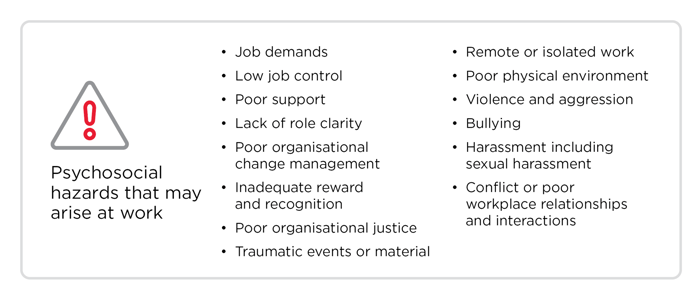Safe Work Australia has recently introduced a model code of practice Managing psychosocial hazards at work (Psychosocial Hazards Code). This is an approved code of practice under section 274 of the model Work Health and Safety Act 2011 (Cth) (WHS Act). It provides practical guidance on how to achieve the standards of work health and safety required under the model WHS Act and the model Work Health and Safety Regulations 2011 (Cth) (WHS Regulations), and effective ways to identify and manage risks. It has not yet been adopted by any of the harmonised states and territories.
What are SafeWork Australia codes of practice?
According to the Safe Work Australia, “A code of practice is a practical guide on how to comply with the legal duties under the Work Health and Safety (WHS) Act 2011 and WHS Regulations. The Act also outlines how codes of practice can be used in court proceedings. Codes of practice have a special status because an approved code is automatically admissible as evidence in court proceedings under the WHS Act and Regulations."
.png?width=303&name=Codes%20of%20Practice%20(SG).png)
Diagram taken from the Codes of Practice and Guidance Material Information Sheet.
Codes of practice have been developed to assist anyone (or a Person Conducting a Business or Undertaking- PCBU) (see this factsheet on the meaning of PCBU here) who has a duty of care in the circumstances (or subject) described in each code of practice. In most cases following an approved code of practice would achieve compliance with health and safety duties. (For more information see here). There is no doubt that schools that follow approved codes of practice will be better able to achieve compliance with their health and safety responsibilities under the relevant WHS Act and WHS Regulations in their state or territory.
According to the Psychosocial Hazards Code, “The health and safety duties require duty holders to consider all risks associated with work, not only those for which regulations and codes of practice exist”. Similar language is used in other codes of practice and serves to highlight the fact that each code of practice deals only with a particular hazard or health or health and safety compliance issue, (for example work health and safety consultation, cooperation and coordination) and may not cover all other relevant hazards or risks.
What is the SafeWork Australia psychosocial hazards code and why has it been developed?
Section 276 (Schedule 13) of the model WHS Act includes provision for regulations to be made relating to exposure to psychological hazards. However, prior to the development of the Psychosocial Hazards Code, there was no model code focused primarily on psychological health or how to manage psychosocial risks or hazards.
Clayton Utz in their article Safe Work Australia finalises Code of Practice for psychosocial hazards has published an excellent summary of the Psychosocial Hazards Code.
They note that, following the review of Australia’s model WHS laws in 2018-19, and in reference to the impacts of the COVID-19 pandemic, there has been an increasing focus by all employers on employee mental wellbeing, and better management of psychosocial hazards and risks.
According to the Psychosocial Hazards Code, psychosocial hazards are hazards that arise from or in relation to:
- the design or management of work
- the working environment
- plant at a workplace; or
- workplace interactions or behaviours; and
- may cause psychological and physical harm.
Psychosocial hazards identified within the Code (pp 16-18 and Appendices A and B) include:
 Diagram taken from the Managing psychosocial hazards at work, code of practice.
Diagram taken from the Managing psychosocial hazards at work, code of practice.
What is the legal effect of the psychosocial hazards code?
States and territories with harmonised health and safety laws have provisions for codes of pratice to be approved by the relevant Minister in their state. An approved code of practice applies to anyone who has a duty of care under health and safety legislation in the state or territory where it is approved.
Once approved, an approved code of practice is admissible in court proceedings and will generally be regarded as the standard for determining whether the management of a hazard meets the standards required under the relevant health and safety laws and regulations.
Regarding the legal implications of the Psychosocial Hazards Code, Clayton Utz, in their article note the following:
“While an approved code of practice is not legally binding, Courts may regard an approved code of practice as evidence of what is known about a hazard, risk or control and may rely on the relevant code to determine what is reasonably practicable in the circumstances. The recommendations contained in the Code do not represent the only acceptable way for PCBUs to discharge their obligations. Where alternative approaches achieve the same or better results, this will satisfy the legal standards.
Organisations will likely have risk management systems in place to manage their current hazards. Employers should however carefully review their current practices alongside the Code and the Model Regulations to ensure they have appropriately identified the psychosocial hazards in their organisation, and the control measures to manage these, to make sure they are meeting their legal requirements.”
What do schools need to do now?
In a nutshell, although the Psychosocial Hazards Code has not yet been approved in any of the harmonised jurisdictions, it represents ‘best practice’ and over the next few months schools in the harmonised jurisdictions should review all of their risks and controls associated with psychosocial hazards that may arise in their workplace. Schools in New South Wales and Western Australia should currently refer to their existing Codes of Practice in relation to psychosocial hazards.
The Psychosocial Hazards Code sets out guidance on how to identify psychosocial hazards and information regarding how to assess and control the risks. Schools that have effective risk management programs and practices would have no issues with the latter part of the process. It is recommended that, schools:
- in consultation with their staff, identify all their school specific psychosocial risks (use the table of hazards from the Code as a starting point),
- are reminded that hazards can interact or combine with each other (interrelationships) and thus may also change or increase the risks,
- assess each identified risk, for duration, frequency and severity,
- using current or develop new controls (e.g. new training) to remove each risk or minimise it as far as practicable,
- review their controls for effectiveness
- record all the steps that they followed.
Schools should continue to check with their state or territory health and safety regulator to confirm whether the Psychosocial Hazards Code has been approved in their jurisdiction.
Schools want to retain quality staff and maintain safe working environments, so they should look to the SafeWork codes as best practice to enable them to manage their responsibilities and accountability for their staff and all workers (including students and volunteers) to the best of their ability.



.png?width=303&name=Codes%20of%20Practice%20(SG).png)



